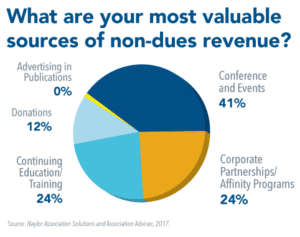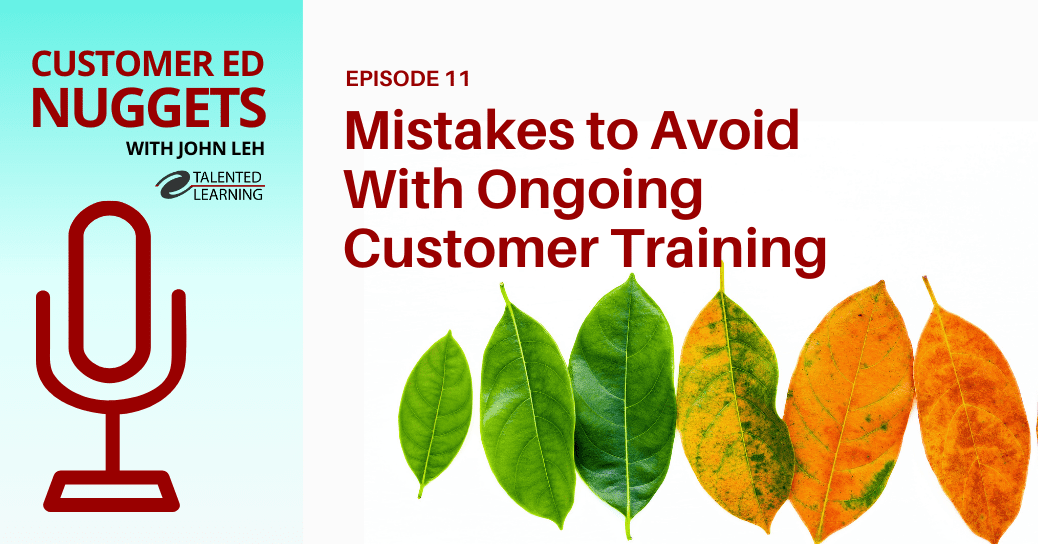
Way back in 1953, when the American Society of Association Executives (ASAE) first reported industry financial benchmarks, membership dues represented a whopping 96% of the typical organization’s revenues. But those dues-driven days are long gone. In fact, by 2016, subscription income averaged only 45% for trade associations and 30% for professional associations.
 In the meantime, continuing education has gained significant ground as a revenue driver. Currently, learning programs contribute nearly 25% of average non-dues association revenue, according to a 2017 Association Adviser poll.
In the meantime, continuing education has gained significant ground as a revenue driver. Currently, learning programs contribute nearly 25% of average non-dues association revenue, according to a 2017 Association Adviser poll.
And going forward, professional development is expected to become even more integral to the non-dues revenue mix – fueled by members’ desire to keep pace with the rapidly changing world of work.
Every association already offers at least some level of education to its members. But as the economics of member-based organizations shift, leaders can no longer afford to ignore a fundamental strategic question:
How can your association provide more valuable education to more people – and charge more for it – so you can fund continued expansion?
The answer may not be simple, but it is clear. By thoughtfully implementing modern learning tools, content and delivery methods, you can provide high-value continuing education that complements your broader mission and purpose.
And as many leading-edge associations have discovered, one of the most powerful tools you can choose is a learning management system (LMS) designed specifically for member-based organizations.
Exactly how can an association learning system help you make the most of this opportunity? Here are four of the most compelling ways it add can add measurable value:
4 High-Value Benefits of Association Learning Systems
1) Increased Revenue Streams
According to a 2015 Pew Research study, 74% of U.S. adults are actively committed to lifelong learning for professional and/or personal enrichment. That same study revealed that 63% of U.S. workers demonstrated a commitment to professional learning by participating in some form of training during the prior year.
 These findings support what smart associations already recognize. Their members want to develop relevant knowledge and skills throughout their careers.
These findings support what smart associations already recognize. Their members want to develop relevant knowledge and skills throughout their careers.
And they often turn to associations first for reliable continuing education in all its forms – webinars, self-paced learning, online courses, virtual meetings, videos, blogs, conference materials, reference guides, mentoring programs and other content that helps them learn and reinforce skills, obtain certifications and stay competitive. Effective association learning systems facilitate delivery and tracking of all these learning activities, including related purchasing transactions.
2) Sustainable Membership Growth
Individuals are drawn to associations for the benefits they receive – and learning opportunities are often one of the most effective ways to attract new members. An association learning system can serve as a robust and highly accessible backbone for personalized “push” and “pull” marketing that boosts new member acquisition, while simultaneously reinforcing ongoing engagement and retention among existing members.
It can also support expansion beyond an organization’s existing geographic base by providing multi-language resources in an on-demand environment. So, in addition to driving increased engagement and “share of wallet” from existing members, associations can leverage an LMS to continuously expand their base to new market segments.
3) Reduced Operational Costs
Not long ago, in-person events and classroom training were the gold standard for continuing education. But with the rise of high-speed internet connections, cloud computing, mobile devices, video compression and other recent innovations, online learning has become the norm.
Online learning minimizes content and administrative costs by letting associations develop courses and related content only once for delivery across multiple channels. It also helps members avoid steep travel expenses and loss of productivity that may have prohibited them from participating.
An LMS makes it possible to reach learners wherever they are on whatever browser or device they choose, at their convenience. What’s more, the savings can be reallocated to additional professional development opportunities.
4) Streamlined Certification and Accreditation Processes
In the U.S., professional licenses and credentials are governed by state regulations. In other words, each state has its own standards dictating how professionals and organizations must obtain, maintain and renew various certifications and accreditations. This is difficult to manage even with an LMS – but it is nearly impossible without one.
An association learning system provides a convenient, centralized online management tool for members who need to identify various continuing education requirements, track the history and status of their professional credentials, and easily access other related information.
What to do Before You Buy (or Replace) an Association Learning System
When planning for a new or updated LMS, it pays to assess your needs thoroughly before contacting vendors. Why?
Our research has identified more than 700 enterprise-level learning systems available today. It’s wise not to waste valuable time and resources searching for a needle in this haystack of possibilities. Instead, focus first on these steps:
1) Clarify Your Learning Business Strategy
Only 30% of association professionals are “very satisfied” with their LMS, according to a recent survey by technology provider, Abila. That may seem like a grim statistic, but closer inspection suggests that another factor may be influencing these outcomes. Dissatisfaction may not be entirely because platforms are falling short, but because LMS buyers are unsure of their requirements.
The best way to avoid this misstep is with a learning strategy that maximizes revenue growth while reinforcing your association’s overall mission. A strong strategic framework should help you identify priorities, narrow choices, guide decisions and focus on activities with the strongest impact. Unless you can articulate your strategy, you’re unlikely to find an appropriate LMS – and you’ll put your broader organizational goals at risk.
2) Consider Your Entire Ecosystem
These days, no LMS can effectively operate as a standalone application. Rather, it must integrate with other functional and business systems, as well as other tools and resources that “live” inside and outside of your organization’s firewall. Think of your LMS as a fundamental layer of this diverse and fluid learning ecosystem.
For example, learning data should seamlessly share data with systems designed for content development, finance and association management.
Cloud-based systems and integration platforms make this easier, but upfront planning can help minimize unexpected obstacles. Reach out to your IT team in advance to discuss their integration issues, concerns and requirements.
3) Calculate ROI
Choosing a new or replacement LMS can lead to a significant return on investment (ROI) – but outcomes are not guaranteed.
Start with a snapshot that quantifies existing costs as well as the income you generate from existing learning content. As you research these factors, you’re likely to uncover issues that will inform your future LMS requirements.
Next, estimate costs of implementing and managing a new system, along with the income you expect to generate from it over a reasonable time horizon (for example 3 years). Early in this process it helps to establish multiple scenarios – pessimistic, realistic and optimistic. If you’d like a framework for these calculations, many are available, such as this simple ROI spreadsheet from association LMS vendor Digitec Interactive.
Keep in mind that some sources of ROI are more obvious than others. For example, most organizations expect financial benefits from streamlined administrative processes, improved content development efficiency, broader member adoption and increased per-member purchases. These should be quantified as specifically possible in terms of tangible and intangible cost savings, as well as expected income.
It’s also important to investigate the numbers carefully to pinpoint potentially hidden benefits. For instance, you may find ROI by aggregating and analyzing learning data to make better decisions about course topics to develop.
4) Don’t Overlook Change Management
Many people in your organization may recognize that that change is necessary. They may even support it in theory. Yet they may not like or accept new technology or processes right away. Resistance is a normal human reaction to change, even when it is beneficial. So before the project begins, it helps to anticipate change management needs.
At a minimum, expect to initiate frequent communication throughout the development process and deliver training to all stakeholders. Consider the various audiences that will be using the new system and tailor communications, accordingly. If you apply the basic principles of technology adoption, people are far more likely to embrace your new solution.
Conclusion
Competition is fierce in today’s professional development market, but member-based organizations have a natural advantage over the myriad other continuing education content providers. If your organization wants to sell more – with more profitable results – you’ll need to accommodate the preferences of today’s anytime, anywhere, any-device learning consumers.
Many association learning systems can help you achieve this goal. But to find the straightest path to your best LMS match, you’ll want to invest in some upfront planning.
It shouldn’t be difficult to make the case for an LMS that adds value by attracting new members and increasing your non-dues revenue. Your members already look to you for continuing education – so why not provide a learning experience they’ve come to expect as online consumers? The investment you make in an association learning system today is likely come back to your organization many times over tomorrow.
Thanks for reading!
WANT TO LEARN MORE? JOIN THIS ON-DEMAND WEBINAR!
LMS Selection Step-by-Step
With hundreds of learning systems available today, finding the right LMS for your unique extended enterprise needs can be tricky. But with so much at stake for, it’s worth the extra effort.
What exactly should you do to choose the best solution?
Walk step-by-step through a real-world example with John Leh, CEO and Lead Analyst at Talented Learning. You’ll learn:
- How to develop a relevant business case and success metrics
- Methods for researching and defining use cases and requirements
- When to issue an RFP (or not)
- Tips for creating a viable LMS shortlist
- How to make the most of vendor demos and proof-of-concept projects
Need Proven LMS Selection Guidance?
Looking for a learning platform that truly fits your organization’s needs? We’re here to help! Submit the form below to schedule a free preliminary consultation at your convenience.
[gravityform id=”18″ title=”false” description=”false”]Share This Post
Related Posts
The Future of Customer Education: Customer Ed Nugget 16
Customer education is rapidly evolving as organizations embrace new strategies and tech. What does this mean for the future of customer education? See what experts say on this Customer Ed Nuggets episode
Education Strategy Mistakes to Avoid: Customer Ed Nugget 15
What does it take to deliver a successful customer education program? It starts with a solid education strategy. Learn how to avoid common pitfalls on this Customer Ed Nuggets episode
Which LMS is Best for You? New Shortlisting Tool for 2024
How can you find the best learning system for your business? Our LMS shortlisting tool can help. Learn about the 2024 RightFit Solution Grid. Free, reliable guidance based on our independent research
How to Build a Learning-Based Business: Executive Q&A Notes
Building and selling online courses may seem easy, but building a profitable learning-based business is far more complex. Find out what successful leaders say about running this kind of business
The Rewards of Community Building: Customer Ed Nugget 14
What role does community play in your customer relationships? Find out why community building is such a powerful force in customer education on this Customer Ed Nuggets episode
Benefits of Training Content Syndication: Customer Ed Nugget 13
If you educate customers online, why should you consider content syndication? Discover 10 compelling business benefits in this Customer Ed Nuggets episode
Top Marketing Skills to Master: Customer Ed Nugget 12
Successful customer education programs depend on professionals with expertise in multiple disciplines. Which marketing skills lead to the best results?
How to Measure and Improve Partner Training ROI
An educated channel is a successful channel. But how do you know if your educational programs are effective? Learn from an expert how to evaluate partner training ROI
Mistakes in Ongoing Customer Training: Customer Ed Nugget 11
Customer education doesn't stop with onboarding. It pays to invest in ongoing customer training. Learn which mistakes to avoid in this Customer Ed Nuggets episode














FOLLOW US ON SOCIAL